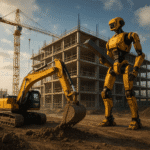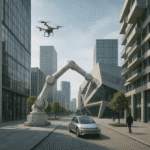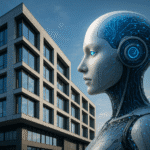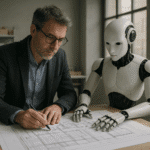The confluence of cutting-edge computation and visionary construction techniques is reshaping the built environment. Architects, engineers, and technologists are collaborating to forge a new era where buildings not only exist as static monuments but evolve into living, adaptive entities. This exploration delves into the realms of futuristic architecture, exploring the pivotal role of artificial intelligence in driving design innovation, environmental responsiveness, and ethical stewardship.
Intelligent Design Paradigms
Architectural forms are increasingly conceived through the lens of algorithms that process vast datasets, simulate environmental factors, and propose optimized solutions. Gone are the days of purely manual drafting; today’s studios leverage computational power to experiment with complex geometries and performance-driven aesthetics.
Generative Algorithms in Action
Generative design tools employ evolutionary logic and machine learning to iterate thousands of variations in minutes. By inputting parameters—such as solar orientation, load requirements, and material limits—these systems produce proposals that balance structural integrity with visual impact. The result is a new class of forms that often mimic organic shapes seen in nature, a phenomenon known as biomimicry.
Parametric Modeling for Performance
Parametric modeling platforms allow architects to embed rules and constraints directly into digital models. Adjusting a single slider can ripple through an entire façade, ensuring optimal shading, maximizing daylight penetration, or reducing wind loads. The synergy between human intuition and computational precision opens avenues for highly customized yet efficient solutions.
Adaptive and Responsive Environments
Buildings of the future are envisioned as dynamic, rather than static. They will sense, learn, and respond to occupants’ needs and environmental changes in real time. At the heart of this transformation lie networks of sensors, actuators, and AI-driven control systems.
- Cyber-physical systems integrate digital intelligence with mechanical components to regulate lighting, temperature, and airflow automatically.
- Real-time data analytics optimize energy consumption by predicting occupancy patterns and adjusting heating, ventilation, and air conditioning accordingly.
- Interactive façades can alter transparency, color, or shape to improve comfort and aesthetic appeal throughout the day.
Smart skins equipped with nano-material coatings respond to humidity and pollution levels, actively filtering air and harvesting energy. In residential towers, embedded AI assistants learn inhabitants’ routines—adapting living spaces for work, leisure, or wellness. Public infrastructures, from transit hubs to cultural centers, leverage these adaptive strategies to enhance crowd management, safety, and user experience.
Material Innovation and Construction Automation
Advances in material science, paired with robotic fabrication, are redefining construction methodologies. From prefabricated modules to on-site 3D printing, the integration of 3D printing and robotic arms promises speed, precision, and reduced waste.
- Concrete extrusion robots can lay down complex structural components directly from digital blueprints, minimizing on-site labor and error.
- Self-healing bio-concretes embedded with bacterial spores seal & repair micro-cracks, enhancing sustainability and longevity.
- Composite materials infused with nano-fibers offer high strength-to-weight ratios, opening possibilities for slender, cantilevered structures.
Automated assembly lines and drones expedite material transport on large-scale sites. AI-driven logistics platforms orchestrate supply chains, ensuring components arrive just-in-time, reducing storage needs and carbon footprint. This synergy of automation and intelligent oversight accelerates project timelines and maintains rigorous quality control standards.
Ethical and Societal Dimensions
As architecture becomes more entwined with AI, questions of privacy, equity, and human agency arise. Digital twins—virtual replicas of buildings and cities—enable exhaustive simulations but also collect immense personal data. Safeguarding this information is paramount to maintain public trust.
Balancing Innovation with Responsibility
- Transparent AI models should be deployed to avoid biased decisions in space allocation or resource distribution.
- Inclusive design practices must ensure that adaptive technologies serve diverse user groups, preventing a divide between technology-rich and underserved communities.
- Regulatory frameworks should mandate environmental impact assessments for data centers powering massive AI operations, addressing the energy demands of high-performance computing.
Collaborations between architects, ethicists, and policymakers will shape guidelines that prioritize well-being over mere novelty. By aligning AI-driven strategies with social values, the built environment can become more resilient, equitable, and human-centric.
Urban Planning Reimagined
The integration of data-driven insights revolutionizes large-scale urban planning. Municipalities harness AI to model traffic flows, optimize public transit routes, and predict demographic shifts. By overlaying environmental simulations with social metrics, planners can craft neighborhoods that seamlessly adjust to future challenges.
Imagine a district where streetlights dim or brighten based on pedestrian volume, public parks modulate irrigation according to weather forecasts, and building footprints evolve in response to projected housing needs. This real-time, adaptive approach fosters vibrant, resilient communities that grow organically with their inhabitants.
The fusion of architecture and AI heralds a new paradigm: one where creativity is augmented by computation, environments become symbiotic entities, and societal benefits are woven into every structural decision. As we continue to innovate, the partnership between human vision and machine intelligence will define the skylines—and life—of tomorrow’s cities.










